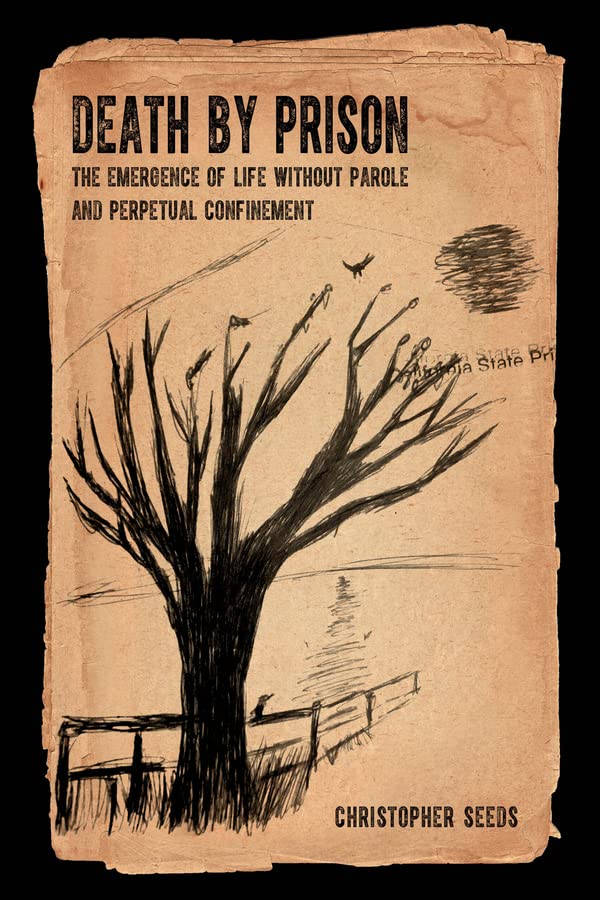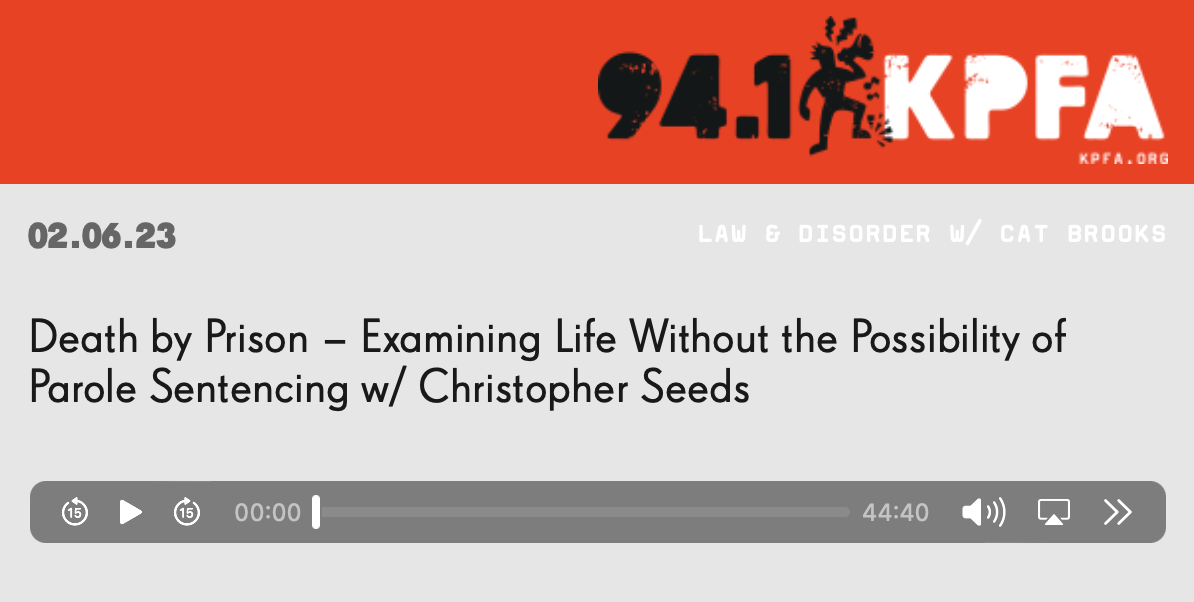
Seeds talks about his absorbing book Death by Prison
Tens of thousands of souls are in prison for life without parole and tens of thousands more are serving sentences that will result in them dying in prison. How that came to be in the land of the free is examined in Death by Prison: The Emergence of Life without Parole and Perpetual Confinement (University of California Press, 2022) by Christopher Seeds. The assistant professor of criminology, law and society was recently interviewed by Matt Coker about his absorbing new book.
 Why is Death by Prison important, why did it need to be written now?
Why is Death by Prison important, why did it need to be written now?
Death-in-prison sentencing—some recognize it as a life without parole sentence, some call it death by incarceration. I use the term perpetual confinement. Some say the “other death penalty.” But what all of these refer to is a prison sentence from which you’re never released. You die in prison. And if you committed the crime for which you are sentenced in your 20s or 30s, as many people do before aging out of crime when they’re older, it means you die in prison after having spent 30, 40, even 50 years inside. Many tens of thousands of people are now sentenced to die in prison in the United States. How did it get this way? How did this country come to use death-in-prison sentencing so much and so routinely? That’s what I wanted to examine. The book researches the historical development of death-in-prison sentencing to understand this country’s comfort level with an incredibly severe punishment.
I emphasize in the book’s introduction that the most important sources of information about life imprisonment are the voices of people directly affected by it: incarcerated people, formerly incarcerated people, their families, friends, communities. I also emphasize that something more is critical too, as a complement to incarcerated people’s statements about their experience: a historical account of how the United States came to use death-in-prison sentencing so regularly. That history had not been written before, and I think it matters. When you’re trying to get rid of something, to abolish something, it helps to know where it came from and to know that history accurately. I think a lot of people fighting against life without parole—and against death-in-prison sentencing more generally—have wanted an account that looks at life sentencing across the United States over a long period of time. This book provides it, and I hope more will follow.
How did you go about conducting the research that informs Death by Prison?
One of the first steps I took was to survey existing literature on life sentencing. That was in the early 2010s. I found there were not many books and articles dedicated to the topic. There were a couple significant works, but otherwise information on life sentencing was not centralized; rather, one would find sentences or paragraphs on life sentencing strewn throughout works on punishment more generally. In my view, two aspects in particular were missing: a base of empirical information about life sentencing and a broad historical scope of reference.
My approach to the research was to operate on both levels. On the one hand, to generate a deeper empirical foundation, I engaged in studies of local arrangements, local struggles, looking in legislative proceedings, executive files, case law, and archives (state archives as well as topic-specific archives such as the National Death Penalty Archive in Albany, New York). On the other hand, I sought a long view of how life sentencing developed in the United States by assembling all mentions of lifetime punishments I could find in primary and secondary historical sources. I simultaneously started charting session laws and statutes, from the colonies forward, to see how, when, and where life sentences, and specifically life without parole sentences, were used. The result, I hope, is a book that offers both a long historical perspective and a detailed inspection of actual processes that took place at the state level and in key institutions like the U.S. Supreme Court and the national anti-death penalty movement.
Having been a lawyer who handled death penalty cases, did anything you uncovered in your research surprise you?
Before studying for a Ph.D., I was a post-conviction and appellate lawyer representing people on death row. As a capital defense lawyer, I was focused on getting rid of the death penalty for my clients. For me at that time, a life without parole sentence (or LWOP) seemed like a victory. In the day-to-day work of capital defense, LWOP was cast as a preferable alternative. The more attention I give to studying death-in-prison sentencing and the more time I spend talking with people who have served or are serving LWOP, the clearer it becomes how brutal this punishment is. So, when I turned to look closely at the history of life sentencing in the United States, I was surprised by a couple things. First, the life without parole sentence has not always carried with it an expectation of death in prison. As the book explains, for much of the twentieth century life without parole sentences promised a reasonable possibility of release, only through clemency not parole. Second, prison sentences intended to end in death in prison have been relatively uncommon historically. Death by incarceration, in other words, was not a widespread or routine practice before the late twentieth century.
How does racism figure in sentences that result in people spending the rest of their lives in prison?
Biases based on race factor in prison sentencing in so many ways. As many have emphasized, racial disparities in sentencing are not only a reflection of sentencing proceedings. Biases and stereotypes, ideas linking crime with race, influence behavior and decisions throughout the course of the criminal legal system, in a circuit that runs from social-environmental factors to institutional arrangements such as policing practices and litigation practices to the courtroom and onward. The same is true with death-in-prison sentences: the significance of a person’s race to the likelihood they serve life in prison can begin long before trial and carry on after sentencing through the experience of the sentence itself. In LWOP history, sometimes the racism is quite express and intentional, as with the superpredator myth used to promote permanent incapacitation of Black youth in the 1990s. But one thing the history of LWOP also spotlights is how assumptions based on race and other biases cast certain people as disposable and fuel a tacit acceptance of imprisonment forever without further consideration or review.
What does the evolution of sentencing that led to our current state say about our society?
One aspect that stands out to me is the extent to which the United States lacks a tradition of critical discussion around perpetual confinement. In that regard, one could contrast, for example, European states, which historically have been wary of lifetime sentences as an over-reach of state power. Consequently, in the 1970s and 1980s, as changes to sentencing and corrections practices began to reshape life sentences into perpetual confinements, there was no established dialog to consult concerning limits on the lengths of prison terms, and this is one reason they met with little resistance or challenge. This country has begun to grapple with mass incarceration, but U.S. society remains relatively inattentive to—politically and socially insensitive to—the indignity of incarceration until death. Many of the people serving death in prison sentences today are seniors, they are older, often suffering from multiple serious illnesses, and have been imprisoned for many years. It is time to recognize the social implications of enforcing death in prison. This book is trying to fuel deeper, critical consideration of these practices.
When readers have finished Death by Prison, what do you want them to come away with?
A couple points stand out. First, with LWOP and the wide use of death-in-prison sentencing today, we take for granted what is, in fact, an aberration. The normalization of LWOP and other forms of death-in-prison sentencing is a contemporary phenomenon made possible by certain events and conditions of U.S. punishment in the late twentieth century. When one looks historically, one finds a principle espoused that prison sentences should not exceed life expectancy. That expectation has faded or has run in quite the opposite direction: now life means life, and sentences exceeding life expectancy are normalized, even encouraged. Recognizing this is a starting point for questioning, scrutinizing these practices and the way society thinks about them.
Second, this aberrant form of punishment is not simply a product of punitiveness. Of course, particularly since the late 1980s and 1990s, tough on crime laws and politics have helped LWOP proliferate. But another dimension made LWOP as we know it possible. A theme of the book is that disregard—a lack of care and attention to how people are punished and to the effects of changes in laws and practices on incarcerated people—is critical to the normalization of death-in-prison sentencing. There were major transformations in U.S. punishment in the 1970s and 1980s, including foundational changes to guiding philosophies, that reshaped life sentences, often without much dialog. Many people who may not have outright advocated for death-in-prison sentencing accepted it once it was there. So, one can’t discount lock ’em up politics, but the quiet buildup of LWOP early on through a lack of attention or care is significant. This is one reason why the book’s retelling of death penalty abolition efforts is important, because we see that the national anti-death penalty movement did not initially have a driving role—only once LWOP was already there did the movement circle around it.
Are you hopeful that works like Death by Prison will eventually lead to reforms?
The book itself does not present a policy argument. It provides historical information and analysis for others to use in developing arguments for change. I hope it will be a resource for lawmakers, policy makers, organizers, activists, and advocates wishing to better understand and challenge death-in-prison sentencing in the United States. Historically, this country is now on unique footing in its disregard for the indignity of dying in a prison. I hope the history this book provides will promote a change of perspective and further the view that every person serving a prison sentence should have a meaningful review for release. No one should be sentenced forever without reconsideration.
Professor Seeds talks more about his book on KPFA’s Law and Disorder with Cat Brooks:
 .
.